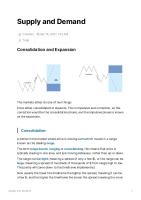Troubleshooting and Repairing ATX Power Supply (By Jestine Yong) [PDF]
Troubleshooting And Repairing ATX Power Supply Brought to you by Jestine Yong Http://www.PowerSupplyRepairGuide.com I ho
42 0 562KB
Papiere empfehlen
![Troubleshooting and Repairing ATX Power Supply (By Jestine Yong) [PDF]](https://vdoc.tips/img/200x200/troubleshooting-and-repairing-atx-power-supply-by-jestine-yong.jpg)
- Author / Uploaded
- Tim Willform
Datei wird geladen, bitte warten...
Zitiervorschau
Troubleshooting And Repairing ATX Power Supply Brought to you by Jestine Yong Http://www.PowerSupplyRepairGuide.com I hope that you have enjoyed the short report of “The Easy Way To Understand Switch Mode Power Supply”. Here I would like to share another article with you that talks about how I have solved a slightly higher output voltages in an ATX power supply. Due to this higher output voltages condition, the CPU would not boot.
Let’ start- One of my customers had asked me to repair his ATX power supply. I told him to get a new one (since it was very cheap nowadays) but he said he couldn’t find one that suits his customer’s CPU. He wanted a power supply that is either same size or smaller then the original one with same or higher specification but all he could find was a standard size ATX power supply! For your information, the standard size ATX power
supply can’t fit into the PC. As a favour to my customer, I took up this repair job. When the power supply was switched on, measurements were taken. The results were over voltage. The 12 volts line shot up to 13 + volt and the 5 volts line became 5.6 volts. After the casing was removed, I found it very dirty and I used a vacuum cleaner and a brush to clean off the dirt. Then I saw four filter electrolytic capacitors had bulged and you could see it at the top of the capacitor.
As you know, we as electronic repairers can’t just see things at only one side; we have to see the surrounding areas too. What I meant was, try to see if there are any suspicious components that contributed to the failure of the power supply such as broken components, dry joints, loose connection, decayed glue and etc before start checking the suspected area.
What I saw was at the primary side there were some components covered with decayed glue as seen in the picture. I have to carefully remove it by scrapping off the layers of the decayed glue while preserving the outer layers of the components. Once it was done, I cleaned it with the Thinner solution. Decayed glue could cause serious or intermittent problem in electronic equipment because it can be conductive.
If you repair any ATX power supply, make sure you check the fan too because some power supply failure was due to heat caused by a faulty fan. The purpose of the fan is to suck out all the heat generated by the components inside the power supply especially the switch mode transformer and Schottky diodes that were attached to a heatsink. In order for the fan to run smooth, you can service it by using a Philips oil base spray as shown in the photo. Remove the sticker behind the fan and open up the small rubber cap and spray the oil into it. If it still would not work then I suggest that you get a new fan because a new fan would not cost much. Once the four electrolytic capacitors were replaced and the decayed glue removed, I then have to plug it into a junk motherboard together with a hard disk to test the performance of the ATX power supply and measure all of its output voltages. It seems like the output voltages were back to normal. Once done, I then tested it in the customer CPU to check for the display. It worked perfectly well.
The reason I tested it on a junk motherboard first so that it would not cause the good motherboard (in the CPU) to go bad just in case if the power supply output voltages were still high. Better safe than regret later. By the way you can’t test an ATX power supply without load otherwise it may turned On for a while and then shut down. This is because, without load the output voltages produced will become very high and this will trigger the protection circuit to shut down the power supply.
If you look at the block diagram from the previous page, if there is no load connected to the power supply, the sense amplifier will send an error voltage to the control circuit and this control circuit will turn off the switching circuit. If the switching circuit is not functioning thus there will be no output voltage because the switch mode transformer is not working. Since you are testing on the junk motherboard first you need to create a switch to turn on the power supply. You need to connect between pin 14 to any ground (Com) pin to turn On the power supply.
Do you know that most ATX power supplies are using Dual Schottky barrier rectifiers to convert the ac wave into DC voltages? Even in LCD Monitor power supply, a Dual Schottky diodes were used in the rectification too.
For your information, checking Schottky diode is different from checking a normal diode. With analog meter set to X10 K ohms, it should show some leakage reading when doing the reverse bias test. If this component becomes faulty it is very easy to get a replacement, of course you have to get one with the right specification. By the way, if you want to become a professional in repairing switch mode power supply you can always get my ebook as it contains all the secrets to easily solve switch mode power supplies problems. Have a good day! Jestine Yong http://www.PowerSupplyRepairGuide.com Feel free to pass this article to your repair friends and colleagues









